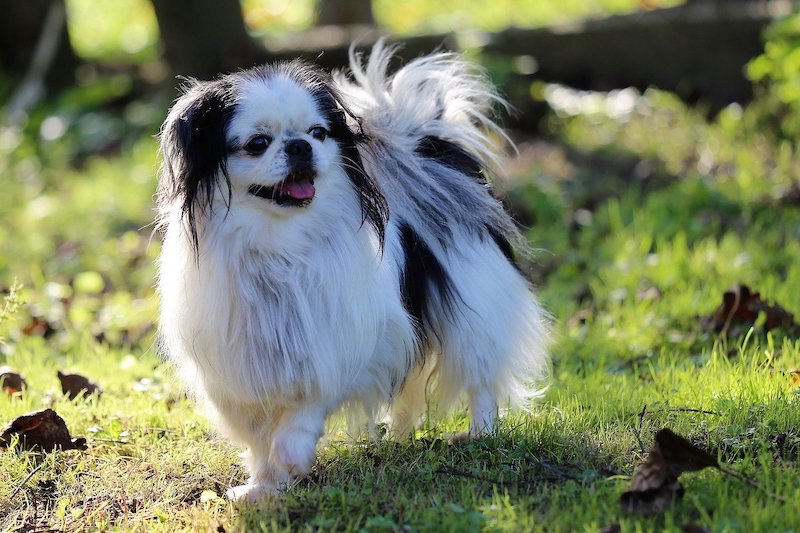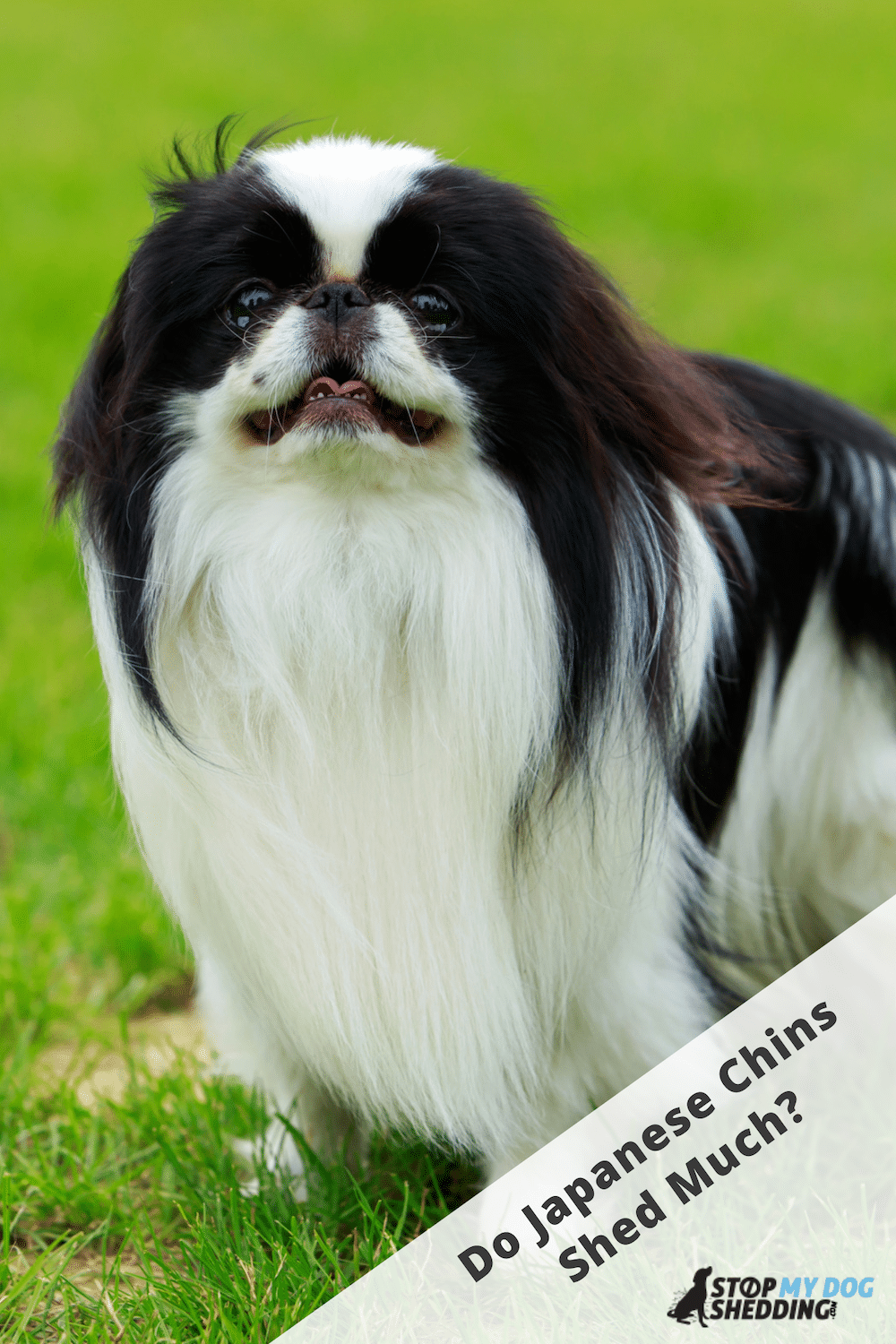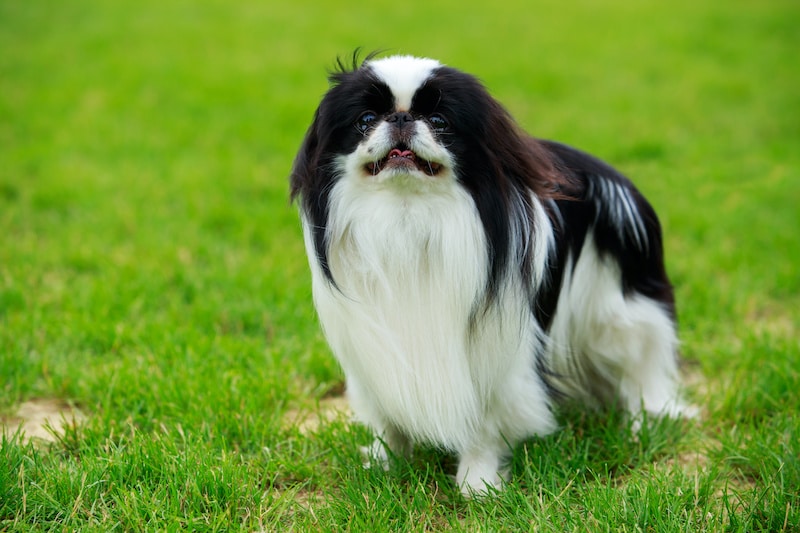Japanese Chins (AKA Japanese Spaniels) are small toy dogs that once served as companions for Japanese nobility. They are now loved the world over, and are known for being cat-like given their fastidious, intelligent and independent nature.
How much hair do they shed? The Japanese Chin is a moderate shedding breed with a long, silky, single coat. They shed regularly throughout the year but a little more during seasons like spring. Thankfully they’re a small breed though, so there’s only so much hair they can lose, and their coat is very easy to maintain.
In this article, we’ll examine just how much hair you should expect to see floating around your home, what it takes to keep it to a minimum and what makes Chins such a special breed.
Recommended: Go here to see our top-rated dog hair blow dryers
Japanese Chin Shedding
Japanese Chins are an average shedder.
To put this into perspective, they shed more than a Bolognese and Iggy for example, which are also small dogs that belong to the toy group. But they shed less than their Japanese counterpart, the Shiba Inu and the Pekingese which Japanese Chins are often mistaken for.
It’s perfectly normal for a dog to shed. Sometimes it can be cause for concern, especially if you suddenly notice excessive shedding or when the hair loss is patchy. But generally speaking, this is just what dogs do.
And because Chins have a tendency to shed seasonally, this can become more noticeable during times like spring and fall. However, they are a single coated breed, so it’s nothing close to what you’d expect to see with a double coated breed.
Some say they are double coated, which is possible if you have a mixed breed, but the American Kennel Club breed standard shows that Japanese Chins are single coated.
They’re also very small in size. So, while this doesn’t impact the rate of shedding, because that has to do with the hair growth cycle, it does mean that there’s less hair they can lose overall. Which in turn means less hair you’re going to have to clean up.
Recommended: Go here to see our top-rated dog hair blow dryers
What Are They Like to Groom?
Surprisingly, Japanese Chins are quite a low maintenance breed. One look at them and you might think they’d be as high maintenance as a breed like the Shih Tzu, but this isn’t the case.
Chins do have longer hair, which is prone to tangles and matts, but it’s nothing a quick going over with a pin brush once or twice per week can’t handle. That’s about all it takes. You will need to spend a bit more time when he sheds his winter coat, but nothing extreme.
A pin brush is a simple, cost effective brush that is made up of stainless steel bristles with rubber or plastic ends on them so as not to irritate the dog’s skin. Simply brush in the direction of her coat, gently working out any matts and you’ll be done in no time.
Some people like to use deshedding brushes, which work quite well, but depending on the level of shedding you are noticing, this may be overkill too.
Recommended: Go here to see our top-rated dog hair blow dryers
Are Japanese Chins Hypoallergenic?
No, Japanese Chins are not hypoallergenic.
The truth is though, no dog is completely non-allergenic. Even breeds with zero hair on their body, like the American Hairless Terrier, can cause allergies to flare up in some people.
The reason for this is because dog allergens don’t come from the fur itself, they come from the dogs dander and dry saliva that attach themselves to that fur. Which naturally means that, the more they shed, the more these spread throughout your home.
So, the term hypoallergenic really refers to breeds of dog that are less allergenic than others, mostly because they don’t shed as much. And since Chins are moderate shedders, they don’t fit into the hypoallergenic breed category.
Recommended: Go here to see our top-rated dog hair blow dryers
Keeping Your Home Hair Free
You cannot stop a dog from shedding completely, nor should you try to do this. Hair loss is a natural occurrence in healthy mammals. Hair grows, stops growing, falls out, and new hair takes its place.
However, there are some very effective ways to reduce shedding to the point it is hardly noticeable. Which means less time cleaning hair off of your clothes, furniture and floors.
And the simplest and most effective method of all, is brushing.
This removes the loose hair directly from your dog’s coat, before it has a chance to fall out. And it helps promote a healthy coat because as you brush, you spread the oils of their coat.
Thankfully, brushing is not difficult with a Japanese Chin, they are among the lowest maintenance breeds out there. So the key is really just consistency.

You only really need to brush weekly to keep his coat in good shape, but stepping this up to 3-5 times per week is fine too. You could even make it a morning routine, or something you do before going to bed every other night.
Provided you are using a quality pin brush and being gentle about it, this shouldn’t irritate his skin, and could make a huge difference to how much fur you notice laying around.
Aside from brushing, ensuring you are bathing him once a month or so and feeding him a healthy, balanced diet can also help. The important thing is to stick with high quality products with good reviews.
This matters because sometimes cheap dog shampoos and foods can cause allergies and dryness, which in turn can lead to shedding. If you’re in doubt, ask your local vet what they recommend the next time you visit.
At the end of the day, Japanese Chins probably aren’t the best breed for someone who wants a sterile home. But the level of shedding is very manageable overall, especially by implementing some of the tips we’ve mentioned here. And considering how adorable these family companions are, I think a bit of extra brushing is well worth the effort.













Please note: By submitting a comment using the above comment form, you confirm that you agree with the storage and handling of your data by this site as detailed in our Privacy Policy.